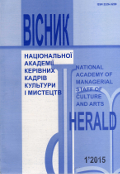DISPOSITION OF THE CHILDREN OF HORUS IN THE SCENE FROM CHAPTER 17 OF THE BOOK OF THE DEAD IN THE CONTEXT OF THE SPATIAL AND THE ANTHROPOGONIC BELIEVES OF THE ANCIENT EGYPTIANS (ACCORDING TO THE PTOLEMAIC SOURCES)
DOI:
https://doi.org/10.32461/2226-3209.1.2015.138339Keywords:
the Book of the Dead, vignettes, Children of Horus, Ancient Egyptian mythology, Ptolemaic PeriodAbstract
The article is devoted to the scene from the number of vignettes-illustrations of the Book of the Dead in the last phase of its existence, the Ptolemaic Period. Some interesting features of the scene were distinguished, according to the previously made compositional and typological analysis. These features are linked with dispositions of the four gods, theChildren of Horus, in the composition of the scene. The most general disposition of gods between each other wasdetermined, what gave an opportunity to interpret this feature. Semantic interpretation was made according to the spatialand anthropogenic conceptions of ancient Egyptians, who connected the Children of Horus with cardinal points and withthe limbs of a person.
Downloads
Published
Issue
Section
License
Authors who publish with this journal agree to the following terms:
1. Authors retain copyright and grant the journal right of first publication with the work simultaneously licensed under a Creative Commons Attribution License International CC-BY that allows others to share the work with an acknowledgement of the work's authorship and initial publication in this journal.
2. Authors are able to enter into separate, additional contractual arrangements for the non-exclusive distribution of the journal's published version of the work (e.g., post it to an institutional repository or publish it in a book), with an acknowledgement of its initial publication in this journal.
3. Authors are permitted and encouraged to post their work online (e.g., in institutional repositories or on their website) prior to and during the submission process, as it can lead to productive exchanges, as well as earlier and greater citation of published work (See The Effect of Open Access).


